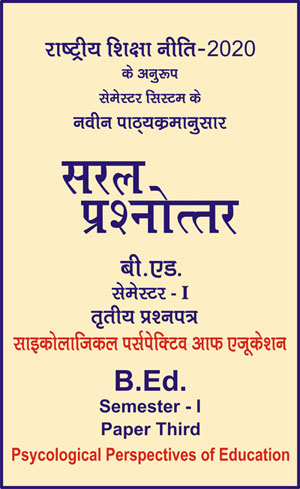|
बी एड - एम एड >> बी.एड. सेमेस्टर-1 प्रश्नपत्र-III - साइकोलाजिकल पर्सपेक्टिव आफ एजूकेशन बी.एड. सेमेस्टर-1 प्रश्नपत्र-III - साइकोलाजिकल पर्सपेक्टिव आफ एजूकेशनसरल प्रश्नोत्तर समूह
|
5 पाठक हैं |
|||||||
बी.एड. सेमेस्टर-1 प्रश्नपत्र-III - साइकोलाजिकल पर्सपेक्टिव आफ एजूकेशन (अंग्रेजी भाषा में)
Question- Explain Adolescents development in Indian context along with their characteristics.
Or
"Adolescence is the most difficult period of life." Explain the statement and describe the problems of an adolescent.
Or
Explain the Adolescents Development.
Or
Describe the Characteristics of Adolescence Development.
Or
Explain the ‘characteristics’ and ‘problems’ of ‘Adolescents’.
Or
Briefly explain the main characteristics of adolescents.
Adolescents Development
Meaning and Conditions : The English word adolescence is NTS derivative of the Latin ‘adolescere’ which means to grow to maturity. This age begins from twelve and continues till the age of twenty. In the words of Jersild, “Adolescence is the period through which a growing person makes transition from childhood to maturity.” Adolescence, in the opinion of most educational psychologists, begins between the age of 12 to 24 years. Compared to boys, girls enter the period of adolescence a couple of years earlier. According to Dr. Jones, adolescence is the recollection of infancy. It parallels the states of infancy and childhood in being patterned into the conditions, the first of growth and the second of maturation.
(4) Religious Feeling : Many adolescents become positively and deeply religious in this period of their lives. One can often observe them loving God in some one image, talking to Him, sacrificing themselves to Him and praying to Him. India is particularly productive of such specimens since, for one, the religious tendency is deeply ingrained in the people’s mind, and for another, in Indian society young boys and girls meet great leaders and famous personalities on very rare occasions. While religious tendency protects the young inexperienced child from many bad habits, it sometimes helps in making him somewhat impractical. Teachers can help to create a healthy attitude towards religion.
(5) Gregariousness : Adolescents are always acutely desirous of being among their friends, or praising them and of improving their relations with them. Often, they form definite groups in with each adolescent has his specific status and a role to suit him. This status and role plays an important part in determining his status and role in adult life.
(6) Extroversion : In this period, the child once again regains his extrovert flamboyance, taking deep interest in his surroundings and other individuals, their activities and conflicts. In school, too, he likes to take part in all kinds of activities. And it is a matter of joy with him if he can spend the larger part of his time in the company of his friends. Various individuals become engaged in programmes of social service and welfare. In this manner does the adolescent announce the interest that he takes in the real world. This interest can be usefully exploited to ingrain in him such useful qualities as self-dependance, self-determination, co-operation, discipline, honesty and the quality of maintaining good relations with others or develop the social instinct. This is the age in which the foundations of good citizenship can be deeply laid.
(7) Lack of stability and Adjustment : It has been pointed out earlier, too, that in his adolescence the growing individual is at the threshold of his life although he is rarely if ever considered an adult by his seniors. From the psychological point of view, he takes himself seriously enough not to consider himself a child, and likes to be treated as an adult. Evidently, he shows considerable instability and lack of adjustment. His adaptation to his environment is upset by such small considerations as the growth of pimples on his face or the presence of other small physical deformities. In fact, it is a stage in which he learns to lead adult life in every sphere and direction. Hence, the presence and continual development of problems is only natural. And these problems are susceptible to ready solutions if the seniors are prepared to extend their sympathetic co-operation and guidance.
(8) Excessive Sentimentality : The adolescent is very sentimental and emotionally unstable although at this age, his mind is fairly well-developed. Of the many feelings that derive him the strongest are the desire to win praise and self-respect, any injury to or repression of them leading to serious malformations and even open rebellion. Sentimentality can be turned to good use in developing cultural traits in the adolescent. Participation in programme of dancing, acting, music, painting etc., makes the emotional life more stable.
(9) Excessive Imagination : Although the adolescent is as much in this world as any other living, yet he is prone to much imaginary flights into the world of fancy. The smallest thing can persuade him to temporarily abandon the world of reality and turn to the imaginary world. Such excessive imagination manifests itself in the strong tendency towards daydreaming, but some gifted children express their creative and aesthetic imagination through literature, music and painting, besides other arts.
(10) Particular Interests : In adolescence, as the individual develops both in mind and body, his interests vary. Progressively the boys and girls develop the interests of their adult counterparts. Girls show this development in such interests as the use of various cosmetics, efforts at appearing beautifully, reading or taking interest in romantic novels, love stories, dramas or poems, participating in music, art and acting programme etc. Boys manifest their approaching adulthood in the form of various active games, running around, doing acts of valour, developing a vocation that they are to pursue in their adult life. Both boys and girls take constant interest in developing friendship with members of the other sex and maturing it to fruition through conversation, intimacy, letters and romance.
(11) Development of the Mind : In adolescence, the mind develops rapidly. The cells of the nervous system increase rapidly, and the chemical composition of the nervous also undergoes a change. In this way, the mind and the nervous system rapidly matures. In this period along with physical and mental development, practice helps to develop mental abilities. Linguistic ability also registers improvement during this period. In this adolescence the child develops the vocabulary that he possesses. His vocabulary reveals general intelligence. Mental development, too, reaches its apex in adolescence. Despite the inevitable individual differences that are invariably present, mental maturity achieves its completion normally by the age of twenty. Practice or experience contributes considerably to this maturation. Normally, the individual’s intelligence continues on the same level, or, in other words, even in different ages the intelligence quotient of an individual remains more or less the same. Many detailed studies have revealed that during the first five years of life, the mental development is greater than that achieved during the following five. In this manner, the mental development during the ages of 10 and 15 is greater than that during 15 and 20, in respect of rapidity. At the age of ten, the mental development of a child is at its fastest. Following this, as the child approaches the stage of adolescence, the speed of mental development slows down. In his infancy, the child only acknowledges and indicates the feeling of sensations, while at the age of three he is in a position to distinguish between objects, animals and human beings. At six, he is capable of describing a picture that he has seen, but in his adolescence he rises above description to the level of interpretation of the pictures that he sees. In this manner, one can see constant development and improvement in the mind’s reactions to stimuli. Generally, an individual’s memory is tested by the number of digits he can remember after they have once been announced to him. In adolescence, the ability to remember digits improves with age and reaches its highest peak at the age of twenty.
Problems to Adolescents
Adolescence is the period of transition form childhood to adulthood which involves many type changes in social behaviour. It is called the period of great-strain and stress. It means the period of adolescence is full of problems. There are different areas of problem.
(1) Physical health adjustment.
(2) Teaching-learning relationship in school.
(3) Occupational problem
(4) Financial problem.
(5) Home life relationship and social adjustment, and
(6) Development of heterosexuality a problem.
(1) Physical Health Adjustment : Physical health is very important factor for adequate social adjustment. Both boys and girls are very particular regarding their physical appearance. Those adolescents who are either under-developed or over-developed have grate problem in adjustment. The important problems of this area are weak eyes, poor teeth, too short or too tall, poor complexion, headaches, frequent colds.
(2) Teaching-Learning Relationship in School : Most of the adolescents face a great problem in adjustment with teachers. Teachers are rigid, conservative and do not change their attitude. Some adolescents reported the problem of showing favour by the teacher to some students. Students resent amount of home work.
(3) Occupational Problem : The greatest single problem which bothers the mind of adolescent boys in India is uncertainly for future vocation. The problem what will do after study ? haunts the mind of adolescent. There is another black side of the picture. That is when he sees that thousands of adolescents are unemployed. The mind of adolescent agitates against the social order, and he becomes rebellious. It is further unfortunate that most of our adolescents study with future planning. When they finish their study they find themselves incapable of taking any independent means of livelihood.
(4) Financial Problem : If we recollect the problems of adolescent of pre-independence period in India, we find that at that time problems were limited. The problems of adolescent have multiplied with the socio-economic development of the country. The problem of money is such a problem. There are many activities of adolescent which involve money. The adolescent needs money. He feels ashamed of begging money form parents. Parents are conservative in providing money for extra activities to their sons and daughters.
(5) Home Life Relationship and Social Adjustment : Adolescents want more freedom to attend social functions but parents do not permit them to move outside the home. This is particularly in case of girls in rural areas.
Second important problem is regarding parent’s high aspiration regarding achievement of their sons and daughters and when they do not come upto their aspiration, there is constant quarrelling among parents and adolescent. Sometimes these quarrels result in dire consequences. Adolescent runs from his home and may commit suicide.
There is lack of understanding between parents and adolescents regarding freedom and money. The parents treat adolescent like a child. They never discuss problems freely with them.
(6) Development of Heterosexuality a Problem : Heterosexual literally means other-sexual. Heterosexuality involves various relationships between the two sexes. Although a growing child develops gradually increasing interest in the opposite sex, prior to adolescence his dominant social interest is with children of his own sex. This interest continues into adolescence but is paralleled by rising heterosexual interests and activities. Ordinarily many of a person’s childhood acquaintances and friendships extend over into the adolescent period. However, these must be restructured to harmonize with his new adolescent role. within which events are seen differently. The socio-economic status of his family and his friends becomes much more important to him than it him than it was when he was a child. Even more important, his motivations become heavily sex tinged. He becomes very much involved in learning all he can about members of the opposite sex. His answers usually come form inadequate, limited, faculty sources. Consequently, a typical adolescent in the United States avoidly seeks knowledge in regard to sex but is in the unfortunate position of not having available adequate source of such information.
(a) Social Motives and Sexuality : Adolescent boys and girls in modern society are preoccupied with social activities and experimentation. Often high schools serve as social laboratories. In the same sense that a group of people do not eat, sleep, and talk in just any way, adolescents do not choose just anybody as a steady boy or girl friend, and do not socialize with him or her in completely random manner. As the social structure of a society becomes more highly developed, acquired tastes and motives become more numerous and perhaps more inhibiting or coercing. This is particularly true for persons belonging to the middle and upper strata of a highly developed society. Many of an adolescent’s ways of expressing his tastes and motives stem from social standards of his particular group. Thus, in his sexual relationships, as in others, he feels a need to “keep up with the Joneses.”
(b) From Homosexuality to Heterosexuality : In itself, bodily and sexual maturation during adolescence has dramatic effects. Long before boys and girls reach adolescence, they have discovered that there is an anatomical difference between the sexes. They also have developed much curiosity with regard to sex and reproduction. However, generally speaking, it is only at the start of his pubescent period that a youth begins really to feel pressures of his organic sexual drives. Changes in his body and physical desires alter the way he sees everything which is related to him, but naturally they bring greatest modifications in his relationships with the opposite sex.
(c) Sex-linked Problems of Adolescents : Since an adolescent’s interest in the other sex is so new and so strong and he has so little accurate understanding of his own sexual nature and that of the opposite sex, he is likely to blunder a good deal in his sexual life. The wide individual variation in rates of sexual maturation often make an adolescent feel out of step and contribute further to the botching of heterosexual affairs.
|
|||||














